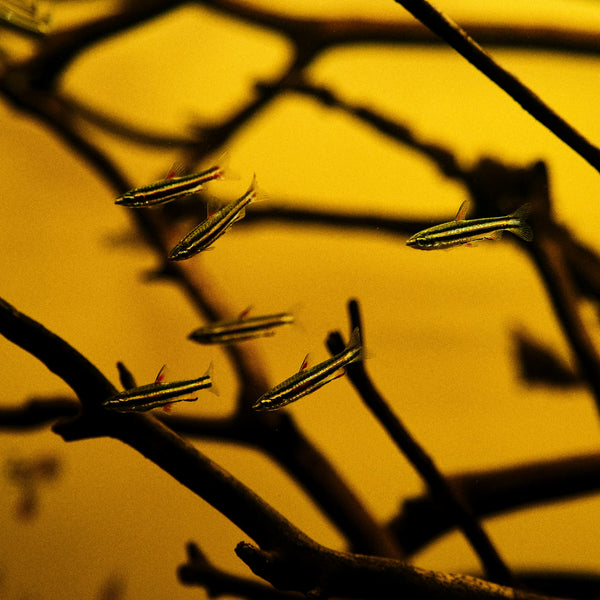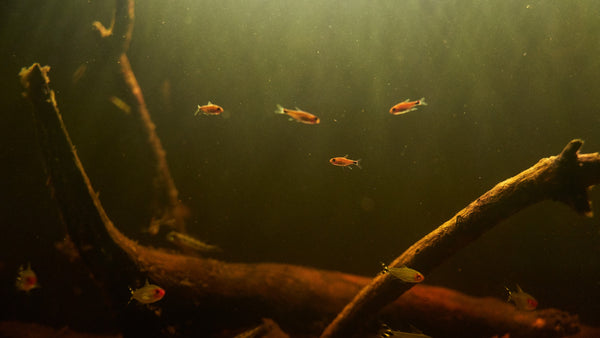- Continue Shopping
- Your Cart is Empty
The mess we make.
As you know by now, I am pretty much near-obsessed with the idea of allowing a botanical-style aquarium to "evolve" with little interference on the part of the aquarist. With botanical-style aquariums, I personally believe that they can better handle evolving on their own more so than many typical systems...Not that I'd want to just "let a tank go", mind you...

I'm a fairly diligent/borderline obsessive maintenance guy. I love my weekly water exchanges. However, I think it's very important to understand the reason why we create aquariums like this. What is the goal? What are we trying to accomplish? If we make an effort to understand the way the natural habitats we are enamored with function, it becomes way easier to manage them in a more confident manner.
Hobbyists unfamiliar with our processes and ideas will call this a mess.
We call it "natural."
I mean, when you think about it, the natural, botanical-style blackwater aquarium is sort of set up to replicate a habitat where all of this stuff is taking place already. Leaves, seed pods, etc. are more-or-less ephemeral in nature, and are constantly breaking down in these environments. Decomposition, accumulation of epiphytic growth, and colonization of various life forms is continuous.
Exactly what happens in these habitats.

As we've discussed before, an aquarium has a “cadence” of its own, which we can set up- but we must let Nature dictate the timing and sequencing. It starts with an empty tank. Then, the lush fragrance exuded by crisp botanicals during preparation. The excitement of the initial “placement" of the botanicals within the tank. The gradual “tinting” of the aquarium water. The softening of the botanicals. The gradual development of biofilms and algae “patinas.” Perhaps, even a bit of cloudiness from time to time because of microbial growth.
Ultimately, there's the decomposition.
It's part of the cycle of life in Nature- and in our aquariums.
All part of a process which can’t be “hacked” or rushed. We can change some of the physical aspects of our tanks (equipment, hardscape, etc.), but Mother Nature is in control.
She "calls the shots" here.
And I think that's perhaps the most important lesson that we can learn from our aquariums. As aquarists, we can do a lot- we can change the equipment, correct initial mistakes or shortcomings the system might have had from the beginning.
We set the stage, so to speak.
However, in the end..it's Nature which does most of the real "heavy lifting" here. Nature rewards us for our good decisions, scolds us for our bad ones, and provides "cues" on what future decisions we need to make. And Nature does it all indifferently...without judgement.
It reacts positively or negatively to our attempts to control it. Both in the wild, and in the confines of an aquarium.

Yes, I know an aquarium is not "Nature"- but it does function in accordance with Nature's laws, regardless of what we want, right? And it is an ecosystem to the organisms which inhabit it.
One of the things that we've seen be more accepted in the hobby over the past few years is a trend towards more "realistic" aquariums. Not just systems which look like natural environments; rather, systems which are modeled as much after the function of them as the aesthetics.
"Functional aesthetics."

I think this is where Tannin Aquatics falls, if you had to nail us down into one specific "stylistic/philosphical approach" to aquariums.
The "space between", so to speak. Sort of straddling multiple approaches, with Nature as the ultimate "critic."
A less rigidly aesthetically-controlled, less "high-concept" approach to setting the stage for...Nature- to do what she's done for eons without doing as much to "help it along." Rather, the mindset here is to allow nature to take it's course, and to embrace the breakdown of materials, the biofilms, the decay...and rejoice in the ever-changing aesthetic and functional aspects of a natural aquatic system- "warts and all" -and how they can positively affect our fishes.

So, that's the whole philosophy behind the botanical-style aquarium and how it functions. How do we best facilitate smooth operation of our systems to accommodate Nature into the process?
We start by accepting the idea of decomposing materials accumulating in our systems. We understand that they act, to a certain extent, as "fuel" for the micro and macrofauna which reside in the aquarium, and that they perform this function as long as they are present in the system.
Sure, if it just bothers the shit out of you, you could remove some of it from time to time. However, I have long been one the belief that if you decide to let the botanicals remain in your aquarium to break down and decompose completely, that you shouldn't change course by suddenly removing the material all at once.

Slow, steady moves are the way.
Our aquariums, much like the wild habitats we strive to replicate, are constantly evolving, accumulating new materials, and creating new physical habitats for fishes to forage among. New food sources and chemical/energy inputs are important to the biological diversity and continuity of the flooded forests and streams of the tropics, and they play a similar role in our aquariums.
We add leaves and botanicals periodically, not just for an aesthetic "refresh", but for a "re-charge" of the biome within our tanks. This is a fascinating spect of the botanical style aquarium. It facilitates the cycle of growth, nutrient accumulation, and decomposition. It becomes not only part of our practice, but it's part of the "system" we are trying to facilitate.

If you look at an aquarium as you would a garden- an organic, living, evolving, growingentity- then the need to see the thing "finished" becomes much less important. Suddenly, much like a "road trip", the destination becomes less important than the journey. It's about the experiences gleaned along the way. Enjoyment of the developments, the process. In the botanical-style aquarium, it's truly about a dynamic and ever-changing system.
Every stage holds fascination.

And, once stuff starts "softening" or breaking down, it doesn't mean that your job is done, or that you're just an observer from that point on. Nope. It means that you're now in a cool phase of "actively managing" (and by "managing", I am emphasizing observation more than "intervening!") the aquarium.
Sure, when you embrace this mindset, you're making minor "tweaks" as necessary to keep the aquarium healthy and moving in the direction-aesthetically, functionally, and otherwise- that you want it to. Yet, at some point early in the process- you find yourself just letting go and allowing the tank to do what Nature intends it to do on it's evolutionary path...

A lot of people may disagree, but I personally feel that THIS phase is the most exciting and rewarding part of the whole process! And perhaps- one of the most natural...if we allow it to be.
And allowing the aquarium to sort of forge its own path, and to process the materials in the closed ecosystem allows Nature to do her thing...
Nature can control. Nature can stabilize. Nature can admonish us...However, Nature can also provide.
We've talked a lot about allochthonous input- food which comes from outside the aquatic environment- such as insects, fruit, seeds, etc. You know, stuff which literally falls from the trees!
However, there is also a significant amount of food which our fishes can obtain which occurs within the aquatic habitat itself.

This is something that we, as lovers of the botanical-style aquarium, are well-suited to embrace. And of course, I'm utterly fascinated by the concept of food production within our botanical-style aquariums! Yes, food production. If you really observe your tank closely- and I'm sure that you do- you'll see your fishes foraging on the botanicals...picking off something.
I've noticed, during times when I've traveled extensively and haven't been around to feed my fishes, that they're not even slightly slimmer upon my return, despite not being fed for days sometimes...
What are they eating in my absence?
Well, there are a number of interesting possibilities.
Perhaps most interesting to us blackwater/botanical-style aquarium people are epiphytes. These are organisms which grow on the surface of wood, botanicals, plants or other substrates, and derive their nutrients from the surrounding environment. They are important in the nutrient cycling and uptake in both nature and the aquarium, adding to the biodiversity, and serving as an important food source for many species of fishes.
THAT is why I think it's advisable to allow botanical materials to break down completely in the aquarium.
No real mind-blowing, world-changing tactic here...well, not on the surface, at least.

Yeah, there are those out there-short-sighted, in my opinion- who view what we do as simply making a mess...
However, if you put some thought into this as a process- a practice that is all about the 'evolving" nature of your aquarium. Something analogous to what goes on in the wild. Something that fosters biological and chemical interactions and impacts we have come to see as part of the fascination of our blackwater, botanical-style aquariums.
Stay diligent. Stay creative. Stay observant. Stay excited. Stay patient...
And Stay Wet.
Scott Fellman
Tannin Aquatics










Scott Fellman
Author